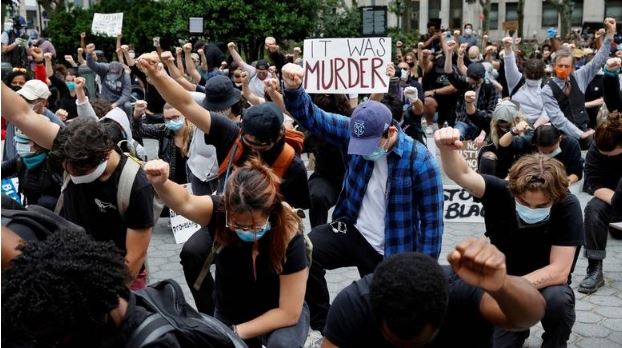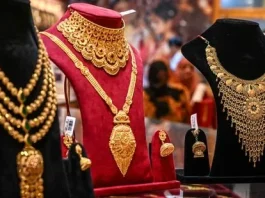But there was relative calm in Minneapolis, where the uprising began following the May 25 death of George Floyd.
Violence and looting spread early Tuesday to more US cities as President Donald Trump faced heated criticism for using force outside the White House to dispel peaceful demonstrators against racial injustice.
Once-in-a-generation protests have brought a multiracial and overwhelmingly peaceful coalition into the streets for the past week but each night has descended into mayhem, with both activists and officials blaming rabble-rousers.
Some of New York’s most storied shopping streets were ransacked late Monday, including the Macy’s flagship, while four police officers were shot in St. Louis, long a hotbed of racial tensions.
But there was relative calm in Minneapolis, where the uprising began following the May 25 death of George Floyd, an unarmed African-American man who was pinned down for nearly nine minutes under the knee of a white police officer, who ignored his pleas for his life.
In Washington, federal police on Monday abruptly fired rubber bullets and tear gas into a peaceful crowd in Lafayette Park outside the White House, permitting Trump to walk through for a brief photo-op at a historic church that had suffered damage the night before.
In scenes reminiscent of the US occupation of Iraq, military helicopters hovered over crowds in downtown Washington, noisily blowing debris as terrified protesters who had defied a curfew fled.
Trump, who has rejected the traditional presidential role of unifier during a national crisis, voiced glee on Twitter over the response in Washington and accused the leadership of New York — led by the rival Democratic Party — of succumbing to “Lowlife & Scum.”
“Overwhelming force. Domination,” wrote Trump, who a day earlier declared himself “your president of law and order.”
– US turned into ‘battlefield’ –
But the strong-armed tactics near the White House triggered outrage as the protesters had been peaceful and a citywide curfew had yet to take effect.
Joe Biden, Trump’s presumptive Democratic rival in November 3 elections, accused Trump of caring only about his own power and said that, if elected, he would tackle the “systemic racism” in the country.
“Donald Trump has turned this country into a battlefield driven by old resentments and fresh fears,” Biden said in a speech in Philadelphia, also hit by violence.
“He thinks division helps him,” Biden said. “His narcissism has become more important than the nation’s well-being.”
Trump on Tuesday visited another prominent religious site, a shrine in honour of pope John Paul II, prompting the leader of the Roman Catholic Church in Washington to say the space was being “egregiously misused and manipulated.”
The late pontiff “certainly would not condone the use of tear gas and other deterrents to silence, scatter or intimidate (people) for a photo opportunity in front of a place of worship and peace,” Archbishop Wilton D. Gregory said.
The United States also faced unusual, if polite, criticism from some of its international allies.
German Foreign Minister Heiko Maas called the anti-racism protests “understandable and more than legitimate.”
“I hope that these peaceful protests won’t slide further into violence, but even more than that I hope that they will make a difference in the United States,” Maas told reporters.
Germany, Britain and Australia all voiced concern about the safety of the media after a number of journalists were roughed up by police or occasionally by rioters.
– Curfew extended in New York –
In New York — which has seen some of the fieriest of the dozens of protests triggered nationwide — Mayor Bill de Blasio extended a curfew through Sunday that will start each night at 8 pm.
It is the first curfew since World War II in the “City that Never Sleeps” and comes just as the metropolis was emerging from weeks under coronavirus lockdown.
The curfew began Monday at 11 pm but New York was already suffering widespread looting, with rioters smashing storefronts on posh Fifth Avenue, pulling electronics from a Best Buy store and breaking into Macy’s, the department store known for its iconic Christmas displays.
Protests each day have begun peacefully. In the diverse Bedford-Stuyvesant neighbourhood of Brooklyn, at least 1,000 people marched Monday, symbolically kneeling as an act of solidarity.
“This is about making leaders listen,” said Cav Manning, 54, a black man originally from London who has lived in New York for 25 years.
“This isn’t just about George Floyd, may he rest in peace. This is about all the black men before, all the black women, all the black children, any people feeling the knee of oppression.”
Mourners plan a service Thursday in Minneapolis to mourn Floyd, who died after being accused of trying to buy cigarettes with a counterfeit bill.
An autopsy Monday called his death a homicide, prompting renewed calls to arrest three fellow officers who assisted Derek Chauvin, facing manslaughter charges over Floyd’s death.
Violence subsided markedly overnight in Minneapolis, leading authorities to consider reducing the number of National Guard forces on the ground.
– Gunfire in St. Louis –
But violence spread elsewhere with four officers shot overnight in St. Louis near the police headquarters after a night of clashes and looting. None of the injuries were life-threatening.
Seattle, the scene of 1999 anti-globalisation protests that remain emblematic for global anarchists, also saw intense scuffles overnight with crowds throwing rocks, bottles and fireworks at police, who responded with tear-gas.
Louisville, Kentucky, was comparatively quiet, a night after police dispersing a crowd shot dead a black restaurant owner — a rare fatality in nationwide unrest that has targeted property.
Louisville is among numerous US cities that had already been seething over the killing of African-Americans.
In March, 26-year-old Breonna Taylor was shot dead in her own apartment in Louisville by police who barged in, alleging her home had been used by drug dealers.



